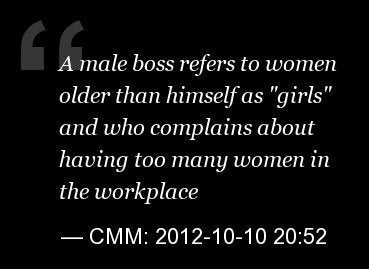As broadcasters, hospital workers and members of the public line up to voice their concerns about TV presenter Jimmy Savile's behaviour towards vulnerable young women, other suppressed memories about worrying workplace behaviour in recent decades are also beginning to surface.
Last week, radio presenter Sandi Toksvig revealed that she had been groped while on air by a "famous individual" 30 years ago.
But have attitudes changed enough?
A website set up by Huff Post blogger Laura Bates to collate instances of sexism, called Everyday Sexism, suggests that many men have still not got the message -- according to their female colleagues.
As the comments show, sexual harassment is alive and well in modern offices. But is it always clear to both sexes where teasing office banter ends and hostile, degrading, humiliating or offensive behaviour begins?
Examples from Everyday Sexism..
Attitudes towards professional women have changed dramatically in the past three decades. Yet, as recently as 2005, amendments were made to the Sex Discrimination Act 1975 to give women better protection from sexual harassment.
According to the TUC, the new regulations mean that if, for example, a colleague persists in making remarks about what nice legs a female employee has, or women have to do their jobs in a workspace where the walls are plastered with the pictures of topless models, they should be able to claim this is sexual harassment.
In Canada, an app was recently developed to give advice on how to deal with sexual harassment in a variety of social settings.
Developed by the Toronto-based Metropolitan Action Committee on Violence Against Women and Children (METRAC), Not Your Baby is designed to provide a range of tailored advice to suit users needs, depending on their situation.

